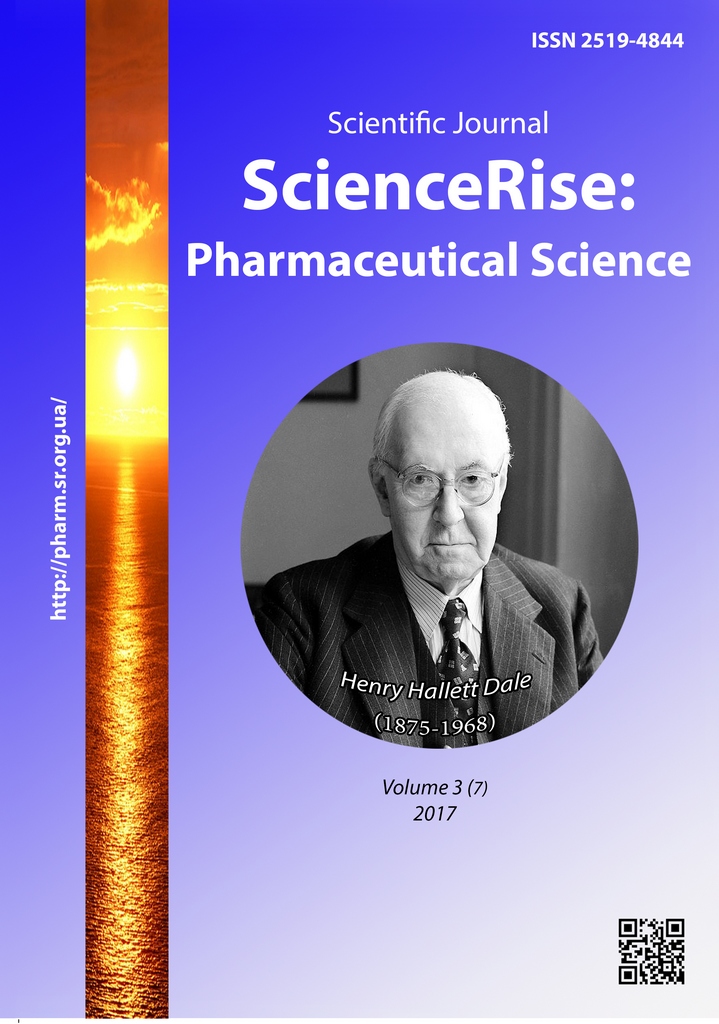Development of procaine hydrochloride and sulfanilamide assay methods in compounding ointment
DOI:
https://doi.org/10.15587/2519-4852.2017.104401Keywords:
compounding ointments, spectroscopy, Procaine hydrochloride, SulfanilamideAbstract
In the modern pharmaceutical market there is a tendency to compounding revival and expansion. Due to this fact, there is a need to develop of modern methods for quality control and stability testing for the given group of drugs. Since most dosage forms are multicomponent, it is necessary to consider the influence of active pharmaceutical ingredients on analysis.
Aim. The aim of research was development of the methods for Procaine hydrochloride and Sulfanilamide determination in the milticomponent ointment on the basis of produced 3% tetracycline ointment with the further use of the developed methods for the remedy stability testing.
Methods. Spectroscopy method was used for Procaine hydrochloride determination, and “Primary aromatic amines determination” method was used for Sulfanilamide analysis.
Results. Due to impossibility of separation of Procaine hydrochloride and Sulfanilamide during sample preparation, it was necessary to develop a method for determination of one of them. For Procaine hydrochloride quantitative determination spectroscopy method at wavelength of 522 nm after formation of associate with methyl orange was offered. To eliminate the other components influence on Procaine hydrochloride absorption, other substances and their mixtures spectra were studied. The linearity of Procaine hydrochloride in the range of application of 80-120% of the nominal concentration in the dosage form was studied. All linear dependence criteria do not exceed the allowable values according to the State Pharmacopoeia of Ukraine requirements.
For Sulfanilamide analysis, Primary aromatic amines determination” method according to the State Pharmacopoeia of Ukraine is recommended, taking into account the estimated amount of titrant spent on Procaine hydrochloride titration.
Conclusion. Spectroscopy method for Procaine hydrochloride quantitative determination and titration method for Sulfanilamide analysis were developed. Statistical criteria of the obtained results of the both methods were calculated. The relative error for Procaine hydrochloride was 1.1 %, and it was 1.39 for Sulfanilamide; these indexes do not exceed the allowable values which allow recommending the offered methods for the ointment analysis and stability testingReferences
- Carvalho, M., Tuleu, C., Taylor, K. (2008). Current Compounding Practices in Europe. International Journal Pharmaceutical Compounding, 2, 94–99.
- Falconer, J. R., Steadman, K. J. (2017). Extemporaneously compounded medicines. Australian Prescriber, 5–8. doi: 10.18773/austprescr.2017.001
- Panda, A., Kulkarni, S., Tiwari, R. (2013). Stability studies: an integral part of drug development process. International Journal of Pharmaceutical Research and Bio-Science, 2 (6), 69–80.
- Bajaj, S., Singla, D., Sakhuja, N. (2012). Stability testing of pharmaceutical products. Journal of Applied Pharmaceutical Science, 02 (03), 129–138.
- Haywood, A., Glass, B. D. (2013). Liquid Dosage Forms Extemporaneously Prepared from Commercially Available Products – Considering New Evidence on Stability. Journal of Pharmacy & Pharmaceutical Sciences, 16 (3), 441. doi: 10.18433/j38887
- Allen, V. L. Compounding, stability and beyond-use dates. Secundum artem, 7 (3). Available at: http://www.perrigo.com/business/pdfs/Sec%20Artem%207.3.pdf
- Derzhavna Farmakopeia Ukrai’ny. Vol. 1 (2014). Kharkiv: DP «Ukrai’ns’kyi naukovyi farmakopeinyi centr yakosti likars’kyh zasobiv», 724.
- British Pharmacopoeia (2012). London: The Stationery Office.
- Amin, A. S., El-Didamony, A. M. (2003). Colorimetric Determination of Benzocaine, Lignocaine and Procaine Hydrochlorides in Pure Form and in Pharmaceutical Formulations Using p-Benzoquinone. Analytical Sciences, 19 (10), 1457–1459. doi: 10.2116/analsci.19.1457
- Ivanov, V. M., Adamova, Ye. M., Figurovskaya, V. N. (2010). Alizarinovyy krasnyi kak okrashennyi reagent dlia ekstraktsionno-fotometricheskogo i tsvetometricheskogo opredeleniia nekotoryh mestnoasteziruyushchih organicheskih osnovanii. Zhurnal analiticheskoi himii, 65 (9), 934–942.
- Georgiyants, V. A., Jevtifjejeva, O. A., Savchenko, L. P., Bisaga, E. I. (2007). Primenenie metoda spectrophotometrii dlia kolichestvennogo opredeleniia procaina hydrochlorida v lekarstvennih formah aptechnogo izgotovleniia. Zaporozhskii medicinskii zhurnal, 2, 129–133.
Downloads
Published
How to Cite
Issue
Section
License
Copyright (c) 2017 Valentin Vrakin, Ivan Bezruk, Lesia Savchenko, Anna Materienko, Victoria Georgiyants

This work is licensed under a Creative Commons Attribution 4.0 International License.
Our journal abides by the Creative Commons CC BY copyright rights and permissions for open access journals.








